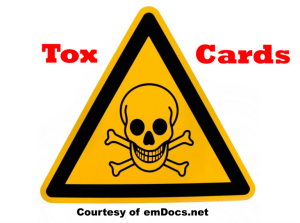Authors: Laurén Murphy, MD (EM3, Cooper Univ Hospital) and Brian Murray, DO (@bpatmurray, Med Tox Fellow, Emory/CDC) // Edited by: Cynthia Santos, MD (Assistant Professor Emergency Medicine, Medical Toxicology, Rutgers NJMS), Alex Koyfman, MD (@EMHighAK, EM Attending Physician, UTSW / Parkland Memorial Hospital), and Brit Long, MD (@long_brit, EM Attending Physician, San Antonio Military Medical Center)

Case:
A 48-year-old man is brought in to the Emergency Department by his wife 2 months after a recent admission for elevated lithium levels secondary to a recent febrile diarrheal illness that caused dehydration. During this admission, he received generous IV hydration with normal saline and was dialyzed with clearance of the serum lithium and was discharged on another mood-stabilizing medication. Today he is complaining of difficulty walking and his wife states that he has been persistently confused. On examination, he is unable to track his finger from his nose to your finger.
Question:
What is the most likely cause of his complaint and findings?
Pearls:
- SILENT is the Syndrome of Irreversible Lithium-Effectuated Neurotoxicity and was initially described in the 1970s [1,2]
- SILENT can occur even at therapeutic doses and has been documented in cases receiving 450mg/day to 8.1gm/day. [1,7] Therefore, lithium level may not be predictive. [4]
- Individuals with preexisting neurologic or cerebral impairment are more likely to suffer permanent sequelae of lithium toxicity [1]
- Infection, dehydration, deteriorating renal function, or the addition of other drugs to the regimen may precipitate acute toxicity. [3]
- Fever from any cause has been implicated in a large number of cases. Fever is thought to precipitate neurotoxicity in cases of SILENT. If the temperature goes high enough, protein coagulation may take place anywhere in the central nervous system (CNS), and this could result in residual sequelae. [1]
- Fever may be an important manifestation of lithium neurotoxicity and lithium-induced fever has been documented under laboratory conditions to be part of the toxicity manifestations of the drug. [5]
- Due to the possibility lithium can induce hyperthermia, fever may actually be predictive of SILENT, more so than the serum lithium concentration. However, there is still debate about this point.
- Onset can be insidious and difficult to diagnose early in the course until symptoms have become florid. [1]
- Typical presentations include any combination of: Persistent cerebellar dysfunction; Persisting extrapyramidal syndromes; Persisting brainstem dysfunction; Dementia with varying degrees of organic mental syndromes [1]
- Most frequent and prominent signs are cerebellar abnormalities, including ataxia as well as dysarthria and “scanning” speech. Patients may also display parkinsonism, nystagmus, tremor, dementia, and difficulty with urine control [1,6]
- Diagnosis is made when symptoms have lasted at least 2 months despite discontinuation of lithium and clearance of lithium from the body. [1]
- Hemodialysis removes plasma lithium, but the shift of lithium from the intracellular compartment back to the serum may be slow, not predicted well by lithium levels while receiving dialysis, and may require prolonged dialysis. [6]
- The neurologic sequelae may persist for varying time intervals beyond 2 months after cessation of lithium, occasionally being reported as long as 5 years after lithium cessation. [1,8]
- There is debate over the precipitating factors of SILENT, however patients with certain clinical factors have a higher risk with acquiring the syndrome. These include: fever, concomitant use of other drugs (esp antipsychotics and antiepileptics), infection of any cause, rapid correction of lithemia, and coexistant illness (esp including heart failure, chronic renal impairment, and epilepsy).
Main Point:
SILENT syndrome is a potentially severely disabling syndrome that is difficult to diagnose but should be included in the differential of a patient with altered mental status and neurologic changes with a history of lithium use. SILENT syndrome is diagnosed when a patient has persistent neurological changes despite being off lithium at least 2 months and can occur even if lithium levels were within normal limits. Fever is associated with the development of SILENT. Although dialysis is a treatment for lithium poisoning, studies do not support that dialysis necessarily prevents SILENT.
References/Further Reading:
- Adityanjee, Munshi KR, Thampy A. The syndrome of irreversible lithium-effectuated neurotoxicity. Clin Neuropharmacol. 2005 Jan;28(1):38–49.
- Von Hartitzsch B, Hoenich NA, Leigh RJ, et al. Permanent neurological sequelae despite haemodialysis for lithium intoxication. Br Med J 1972;4:757-9
- Donaldson IM, Cunningham J. Persisting neurologic sequelae of lithium carbonate therapy. Arch Neurol. 1983;40:747–751.
- Kores B, Lader MH. Irreversible lithium neurotoxicity: an overview. Clin Neuropharmacol. 1997 Aug;20(4):283–99.
- Allgen LG. Laboratory experience of lithium toxicity in man. Acta Psychiatr Scand. 1969;207(suppl):98.
- Porto FHG, Leite MAA, Fontenelle LF, Marrocos RP, Szczerback NF, de Freitas MRG. The Syndrome of Irreversible Lithium-Effectuated Neurotoxicity (SILENT): one-year follow-up of a single case. J Neurol Sci. 2009 Feb 15;277(1-2):172–3.
- Sodhi S, Lee S, Spevetz A. “But the lithium level is normal!” SILENT Syndrome: A rare diagnosis of irreversible lithium toxicity to consider in cases of irreversible neurotoxicity. Trauma Emerg Care. 2016;1:1–1.
- Juul–Jensen P, Schou M. Permanent brain damage after lithium intoxication. BMJ. 1973;4:673.








